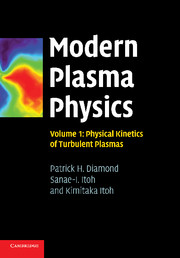Book contents
- Frontmatter
- Contents
- Preface
- Acknowledgements
- 1 Introduction
- 2 Conceptual foundations
- 3 Quasi-linear theory
- 4 Nonlinear wave–particle interaction
- 5 Kinetics of nonlinear wave–wave interaction
- 6 Closure theory
- 7 Disparate scale interactions
- 8 Cascades, structures and transport in phase space turbulence
- 9 MHD turbulence
- Appendix 1 Charney–Hasegawa–Mima equation
- Appendix 2 Nomenclature
- References
- Index
3 - Quasi-linear theory
Published online by Cambridge University Press: 05 October 2010
- Frontmatter
- Contents
- Preface
- Acknowledgements
- 1 Introduction
- 2 Conceptual foundations
- 3 Quasi-linear theory
- 4 Nonlinear wave–particle interaction
- 5 Kinetics of nonlinear wave–wave interaction
- 6 Closure theory
- 7 Disparate scale interactions
- 8 Cascades, structures and transport in phase space turbulence
- 9 MHD turbulence
- Appendix 1 Charney–Hasegawa–Mima equation
- Appendix 2 Nomenclature
- References
- Index
Summary
Nothing can be more fatal to progress than too confident reliance on mathematical symbols; for the student is only too apt to take the easier course, and consider the formula and not the fact as the physical reality.
(Lord Kelvin)The why and what of quasi-linear theory
In the first part of the previous chapter, we discussed fluctuations and relaxation in a stable plasma, close to equilibrium. Now we embark on the principal discussion of this book, which deals with the far more difficult, but also more interesting, problem of understanding the dynamics of a turbulent plasma, far from equilibrium. The first topic in plasma turbulence we address is quasi-linear theory.
Plasma turbulence is usually thought to result from the nonlinear evolution of a spectrum of unstable collective modes. A collective instability is an excitation and a process whereby some available potential energy stored in the initial distribution function (either in its velocity space structure or in the gradients of the parameters which define the local Maxwellian, such as, n(x), T(x), etc) is converted to fluctuating collective electromagnetic fields and kinetic energy. A simple example of this process, familiar to all, is Rayleigh–Benard (R–B) convection, the mechanism whereby hot air rises on time scales faster than that determined by molecular diffusion (Pope, 2000). The starting point is unstably stratified air, which contains gravitational potential energy.
- Type
- Chapter
- Information
- Modern Plasma Physics , pp. 72 - 113Publisher: Cambridge University PressPrint publication year: 2010



